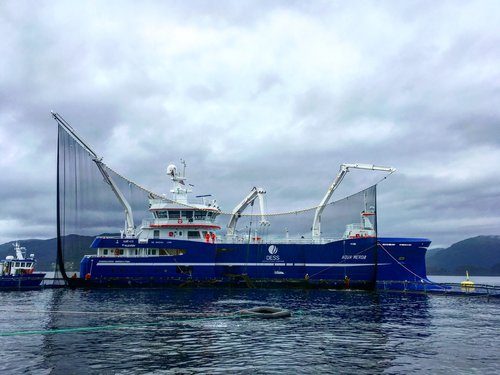Salmon prices drop as Scotland undercuts Norway and Bangkok shuts down.
“There’s a NOK 10.00 ($0.95/€0.89) drop in price across all sizes—no exceptions,” a trader tells SalmonBusiness.
“The krone is strengthening, but the problem is there’s too much fish. And the airfreight market is collapsing. The Scottish market is selling quite a bit lower than we are. They’ve been under us in price all week. That’s unusual. But they’ve been absent for a while, and now they’re back with decent volume.”
Serious situation
“Norway has a lot of fish, high MTB slaughter volumes, strong growth, the whole package. An awful lot of large fish. So now, 6+ kg fish is fetching less than 3–6 kg fish—across all markets. It’s been a long time since that happened,” he says.
The exporters—who typically buy up large volumes of salmon in advance every week—are bleeding.
“It’s serious now. The exporters are doing a fantastic job, but we’ve lost money in ten of the weeks this year. No one appreciates us. That I can promise you. The market sets the price—it’s not up to us. If that’s the case, the farmers can just sell it themselves,” he says, exasperated.
“It’s the same for everyone. Exporters aren’t facing minor losses this year. It’s brutal. No one is willing to lose a million kroner a week. It’s madness.”
He cites the following prices paid to farmers in Northern Norway:
2–3 kg: NOK 64.00 ($6.08/€5.70)
3–6 kg: NOK 70.00 ($6.65/€6.23)
6+ kg: NOK 67.00 ($6.37/€5.96)
“That’s what the customers are willing to pay. At that price, we have a NOK 1.50 ($0.14/€0.13) contribution margin,” he says.
“30 cents lower on 6+. It’s chaos. Bangkok is shutting down. They’re big on airfreighted fish. A massive earthquake down there.”
Wolves
Other sources repeat the same market picture.
“It’s grim. We do tend to complain. Cry wolf. But right now, there are several wolves. It’s tough not being able to hit the price level set by Friday evening. Prices already start to drop then. You begin Monday with a lower price than what you paid for your inventory,” explains a buyer.
He says the large farmers are currently harvesting a lot of fish.
“There’s more fish being slaughtered in Norway—at a time of year when that wasn’t expected. Better growth at sea, less downgraded ‘prodfisk’, and fewer contracts. Volume affects price—one way or another. We don’t take on any fish unless we have a customer lined up. Are we going down NOK 10.00 ($0.95/€0.89)? I don’t know.”
He recognizes a price level of around NOK 70.00 ($6.65/€6.23) for 3–6 kg industrial sizes, and NOK 68.00 ($6.46/€6.05) for large fish.
Flock of sheep
Other market players see the same picture.
“That sounds about right. Based on the week we’ve had, it should really be under NOK 70.00 ($6.65/€6.23) for 3–6 kg. The loss we’ve taken this week will take two months to recover. We exporters are a stupid flock of sheep,” says an exporter, adding:
“NOK 10.00 ($0.95/€0.89) down.”
As a result, farmers may have to kiss goodbye to the sky-high prices seen last spring.
Fish Pool’s forward price (3–6 kg delivered Oslo) for Q2 is €8,100 per tonne, or NOK 91.44 ($8.69/€8.13) per kilo.
SalmonBusiness gathers spot prices for salmon every Friday after lunch, tracking fish to be delivered the following week. This process involves contacting multiple entities in the value chain, including farmers, exporters, and importers. At least five independent sources are consulted, though they may not always be publicly disclosed.


